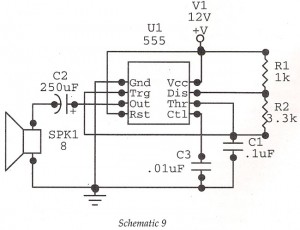
By ASIC delay lamp circuit

A thirty mining lamp control ASIC production delay lamp circuit is straightforward. It utilizes the HL2102 IC from Wuxi Love Core Microelectronics Co., Ltd. The circuit is designed to control a light with a timed delay, allowing for regular intervals when the lamp is activated. The HL2102 comes in a standard DIP-8 package, with pin functions outlined in the relevant documentation. It operates within a power supply voltage range of 2-6V. The circuit can provide temporary lighting at night by pressing a button switch (SH), which turns on the lamp (F). After a set delay of several seconds, the lamp will turn off. If the button is pressed again (SB), the lamp can remain lit. The delay time can be adjusted by changing the value of the timing capacitor and the resistance of a potentiometer (RPs), allowing for timing from a few seconds to several minutes. For extended timing, additional timing capacitors can be added in parallel with the HL2102. The HL2102 is powered by a capacitor that functions as a buck converter, coupled with a half-wave rectifier and voltage regulator for filtering.
The thirty mining lamp control ASIC circuit is designed to manage the operation of a lamp through a simple yet effective delay mechanism. The HL2102 integrated circuit serves as the core component, facilitating the timing and control functions necessary for the lamp's operation. The circuit is particularly useful in applications requiring temporary lighting solutions, such as mining operations where visibility is crucial.
The DIP-8 package of the HL2102 provides ease of integration into various circuit designs, with clearly defined pin functions that allow for straightforward connections to other components. The power supply requirements of 2-6V make the circuit adaptable to different power sources, enhancing its versatility in the field.
The operation of the lamp is initiated through the pressing of the switch (SH), which activates the light (F). The delay feature is a critical aspect, enabling the lamp to remain illuminated for a predetermined duration before automatically turning off. This functionality not only conserves energy but also extends the life of the lamp. The adjustable timing feature is implemented through a potentiometer (RPs) in conjunction with a timing capacitor, providing flexibility in setting the desired delay duration. This can range from a few seconds to several minutes, accommodating various operational needs.
For applications requiring longer delays, the circuit can be modified by adding additional timing capacitors in parallel with the HL2102. This adjustment allows for greater customization of the delay period, making the circuit suitable for a wider range of scenarios.
Powering the HL2102 involves a half-wave rectifier combined with a voltage regulator and filtering capacitor, which ensures stable operation and reliable performance. The choice of components and the design of the circuit emphasize efficiency and simplicity, making it an ideal solution for mining lamp control applications.A thirty mining lamp control ASIC production delay lamp circuit is very simple. Pour in. H L2102 IC Wuxi love core Microelectronics Co., Ltd. (lmp, WV.7W. Wx.sjc.t n) Productio n of light Zhu timed © with integrated circuits, regularly asked to town from child to child BU minutes seconds when wells are free towel concluded, H L2102 standard DIP 8 package, the pin functions shown in Table 31, the power supply voltage range of 2-6V. Figure 85 can be used to get the night l Ke temporary lighting, using just press a button switch SH iLi light F will light up, delay after tens of seconds, the lamp goes out white lines.
The lamp is lit inside called to ask if pressed again SB, lamp F can f/{l against the closure. This circuit since the delay time is short, so the manifold HI.2102 I {, ie first end, song small feet will parallel the timing capacitor H to be adjusted resistance potentiometer RPs value, you can get a few seconds to a few m ten seconds timing. If you ask for more K timing ask, you can HU102 of, feet parallel and then a timing capacitor can be.
I11,2102 for power by the capacitance of T [1 buck, vr) half-wave rectifier, vs regulators and C. Filtering obtained.
The thirty mining lamp control ASIC circuit is designed to manage the operation of a lamp through a simple yet effective delay mechanism. The HL2102 integrated circuit serves as the core component, facilitating the timing and control functions necessary for the lamp's operation. The circuit is particularly useful in applications requiring temporary lighting solutions, such as mining operations where visibility is crucial.
The DIP-8 package of the HL2102 provides ease of integration into various circuit designs, with clearly defined pin functions that allow for straightforward connections to other components. The power supply requirements of 2-6V make the circuit adaptable to different power sources, enhancing its versatility in the field.
The operation of the lamp is initiated through the pressing of the switch (SH), which activates the light (F). The delay feature is a critical aspect, enabling the lamp to remain illuminated for a predetermined duration before automatically turning off. This functionality not only conserves energy but also extends the life of the lamp. The adjustable timing feature is implemented through a potentiometer (RPs) in conjunction with a timing capacitor, providing flexibility in setting the desired delay duration. This can range from a few seconds to several minutes, accommodating various operational needs.
For applications requiring longer delays, the circuit can be modified by adding additional timing capacitors in parallel with the HL2102. This adjustment allows for greater customization of the delay period, making the circuit suitable for a wider range of scenarios.
Powering the HL2102 involves a half-wave rectifier combined with a voltage regulator and filtering capacitor, which ensures stable operation and reliable performance. The choice of components and the design of the circuit emphasize efficiency and simplicity, making it an ideal solution for mining lamp control applications.A thirty mining lamp control ASIC production delay lamp circuit is very simple. Pour in. H L2102 IC Wuxi love core Microelectronics Co., Ltd. (lmp, WV.7W. Wx.sjc.t n) Productio n of light Zhu timed © with integrated circuits, regularly asked to town from child to child BU minutes seconds when wells are free towel concluded, H L2102 standard DIP 8 package, the pin functions shown in Table 31, the power supply voltage range of 2-6V. Figure 85 can be used to get the night l Ke temporary lighting, using just press a button switch SH iLi light F will light up, delay after tens of seconds, the lamp goes out white lines.
The lamp is lit inside called to ask if pressed again SB, lamp F can f/{l against the closure. This circuit since the delay time is short, so the manifold HI.2102 I {, ie first end, song small feet will parallel the timing capacitor H to be adjusted resistance potentiometer RPs value, you can get a few seconds to a few m ten seconds timing. If you ask for more K timing ask, you can HU102 of, feet parallel and then a timing capacitor can be.
I11,2102 for power by the capacitance of T [1 buck, vr) half-wave rectifier, vs regulators and C. Filtering obtained.





